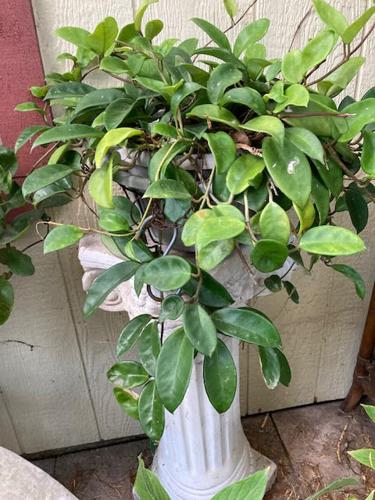MAGICAL HOYAS: Porcelain flowers are air purifiers
September 23, 2023
Gardeners’ Dirt by Dana Wright

PHOTO CONTRIBUTED BY DANA WRIGHT/VICTORIA COUNTY MASTER GARDENER — Hoya carnosa

PHOTO CONTRIBUTED BY DANA WRIGHT/VICTORIA COUNTY MASTER GARDENER – Hoya can be grown in a hanging basket or climbing up a fence

PHOTO CONTRIBUTED BY DANA WRIGHT/VICTORIA COUNTY MASTER GARDENER — A bunch of flowers on a hoya plant

PHOTO CONTRIBUTED BY DANA WRIGHT/VICTORIA COUNTY MASTER GARDENER — Hoya carnosa

PHOTO CONTRIBUTED BY DANA WRIGHT/VICTORIA COUNTY MASTER GARDENER – Hoya flowers are sometimes called porcelain flowers
“Is that real?” is often heard when someone first sees the unusual flowering hoya plant.
Hoyas are also called porcelain flowers, wax flowers, honey plants and vines. They are native to Eastern Asia, the West Pacific and Australia. With the proper care, they can do very well in the Crossroads.
Hoyas are perennial, semi-succulent, green waxy-leafed creepers. They have fragrant, dome-shaped to round blooms called umbels. Hoya is a genus of tropical plants belonging to the dogbane family (Apocynaceae). With over 500 accepted species, only 100 of them flower.
The most common and easily acquired hoya is the hoya carnosa. These plants grow well trailing in hanging baskets or will grow tall if given something to climb. Some hoyas are epiphytes, which means they grow without soil while others are terrestrial.
As with most plants, excellent drainage is important for hoyas. An ideal potting mix is 1/3 each, houseplant compost (premade potting soil), perlite, and cactus mix or orchid mix.
A well-balanced slow-released NPK (Nitrogen-Phosphorus-Potassium) fertilizer, compost tea, or diluted fish emulsion can be applied on a regular 4-6 week schedule or as needed. Your plants will show you when they need help. Do avoid over-fertilizing because it can cause a build-up of minerals and salt.
Most plants do not like wet feet. Poor soil and overwatering create a climate for disaster. Root rot easily weakens hoyas and makes them vulnerable to attack by aphids, mites, mealybugs, spider mites, thrips, and scales.
A common fungus, sooty mold, can be wiped off with a damp cloth. A spray of diluted seaweed fertilizer can also be used to deal with this problem.
Although popular indoors with proper care, Hoyas are easy to grow outdoors. In either environment, hoya plants need bright indirect sunlight for 2-6 hours per day with well-draining, aerated acidic to neutral pH 6.1-7.5 soil. Be sure the soil dries out between watering.
Some hoyas bloom year-round while others prefer a specific season. Low-light situations will grow hoyas well but they may not bloom. Hoyas are tropical plants but direct sunlight will not be beneficial. Warm temperatures plus correct moisture will generate good growth.
Propagating hoyas is quite simple. Take a cutting with two nodes, places where leaves emerge from the stem. Place in a clear container of water or sphagnum moss. Check on them frequently. When the cuttings have a good root system is the time to pot them.
This uniquely beautiful plant can generate calmness or reduced stress when one embraces the beauty and care of hoyas. Tending this plant requires concentration that can help decrease the gardener’s blood pressure.
Recent studies in Georgia, show that hoyas remove pollutants in the indoor environment making the air purer thereby boosting individual’s internal energy. Asian medicine uses hoya for its antioxidant and antibacterial properties. Check online for many other health benefits.
Hoyas do produce a milky, latex sap that should be handled with caution by anyone who is allergic to latex. Good news, hoya plants are pet-friendly, so no urgent trips to the vet if your critters decide to nibble.
To further discover these unique, beautiful, and helpful hoya plants and flowers, peruse the web addresses below and you will be more than amazed. In this Texas heat, we need something that can reflect our state’s beauty and has stamina. Could it be that focusing our attention and care on a beautiful, resilient plant will fit that need?
Hoyas answer the original question: The hoyas is not only real, but it is also magical.
The Gardeners’ Dirt is written by members of the Victoria County Master Gardener Association, an educational outreach of Texas A&M AgriLife Extension – Victoria County. Mail your questions in care of the Advocate, P.O. Box 1518, Victoria, TX 77901; or [email protected], or comment on this column at VictoriaAdvocate.com.
References:
International Hoya Association
lonestarnursery.com/products/hoya-wax-plant